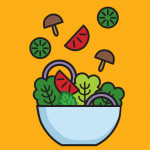According to the Centers For Disease Control and Prevention (CDC), approximately 5-20% of people in the U.S. will catch the flu virus, 200,000 of whom will be hospitalized due to the complications. Although you can catch the influenza virus at any time of the year, it’s alot easier during the fall and winter months--cuz we’re all cooped up inside, often more sedentary, sweating less, moving less--and touching our noses and maybe eyes more often. The added dryness in the air also depletes the protective mucus in our nasal passages, throats and lungs, which seems to make it easier for pathogens to get to their preferred habitats. To protect yourself against the flu, colds and other illnesses this fall, check out the following 4 tips.
#1) Stay Active
Exercise sweating quite possibly being the most important part) plays a direct role in the human body’s immune function. Whether it’s running, jogging, playing tennis, or using your preferred machine at the gym, physical activity stimulates white blood cells and antibodies, sending them throughout the body. This improves the immune system’s ability to fight off infectious diseases, so be sure to exercise on a regular basis this fall.
#2) Increase Your Vitamin C Intake
Vitamin C is a naturally occurring antioxidant that can improve your health and protect against illness. A study conducted in 2007 found that a daily 200 mg dose of vitamin C when taken at the onset of a cold shortened its duration by 8% in adults and 14% in children. (Some report greater success with zinc, especially zinc lozenges.) With fall and winter being prime time for colds, it might be a good idea to push your daily food intake into the direction of getting a minimum of 75 mg of this powerful antioxidant.
Some sources you might not have considered: Pineapple (fresh) 16mg, asparagus 31 mg, grapefruit 26 mg, broccoli (raw) 89 mg, sundried tomatoes in oil 101 mg, raw parsley 133 mg. The humble apple contains so many phytonutrients that it has an antioxidant equivalent of 1,000 mg (as in 1g) of vitamin C.
- Eat plenty of green, leafy vegetables. This includes broccoli, cabbage, Brussels sprouts and collard greens. Eat the vegetables raw or steam them, using only a small amount of water, to maximize the amount of vitamins the vegetables retain.
- Choose fresh and frozen fruits with high vitamin C levels, such as grapefruit, oranges and other citrus fruit, as well as strawberries, cantaloupe, mango, guava, and papaya. All berries are great sources of vitamin C.
- Have a salad with spinach leaves instead of lettuce. Spinach is a better source of vitamin C when eaten raw. Toss in green and red bell peppers and tomatoes for added vitamin C.
- Eat the skin when having a baked potato, as the skin has the highest concentration of vitamin C.
- Use plenty of tomato sauce on your pasta, pizza or vegetables. Or, have a cup of (home made) tomato soup. Tomatoes are a great source of vitamin C no matter how you eat them.
Vitamin C does not last in storage, and is steadily lost the longer the food item is stored. As such, be prepared to eat your food as fresh as possible rather than leaving it to linger in the refrigerator or pantry. For example, leaving your broccoli in the fridge and then boiling it will reduce the vitamin C content considerably compared to freshly picking the broccoli and steaming it that same day. It’s a good motivation to become a vegetable gardener even if you just grow a few balcony broccoli or potatoes in a pot or crate.
- Do not soak fruits or vegetables or store them in water. The vitamin C will leach out into the water. Vitamin C also leaches out in cooking water--so better to steam (even nuke) or stir-fry/lightly sauté.
#3) Remember the Rainbow (“ROY-G-BIV”)
Yet another way to improve your health is to do your best to get every color in your food, every day: red, orange, yellow, especially (dark, bitter) GREENS, blue and purple (violet). (I’m going to substitute white or beige for the indigo. Let’s hear it for the beige: cauliflower, leeks, fennel, celeriac, parsnips, rutabagas, the all powerful mushrooms, even potatoes--which I know will be controversial.) With some notable exceptions, the more color you have on your breakfast, lunch or dinner plate, the better. Foods that are bright orange, red and green are all excellent sources of vitamins and antioxidants. Some ideas include squash, bell peppers, broccoli rabe, Swiss chard, bok choi, escarole--all of which will help keep you healthy throughout the darker, drearier, indoor months.
#4 Make a Soup
There’s no better time than the chilly fall and winter seasons to lovingly prepare a hearty soup. Avoid store-bought soups (and stocks--or read labels carefully), which are usually loaded in sodium and preservatives. Instead, make your own from scratch. This allows you to include a variety of beneficial vegetables and seasoning, tailoring it to your own personal preference.








Comments
Comments